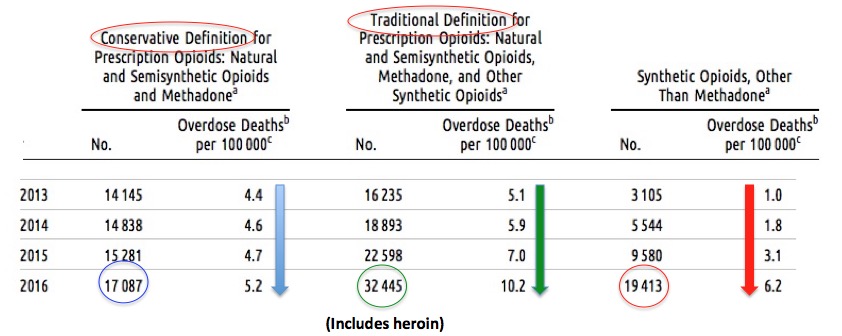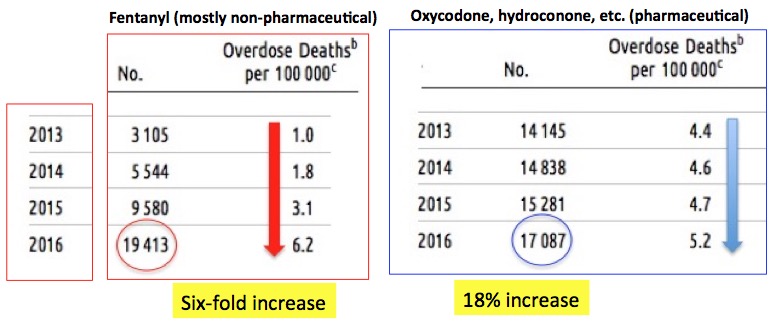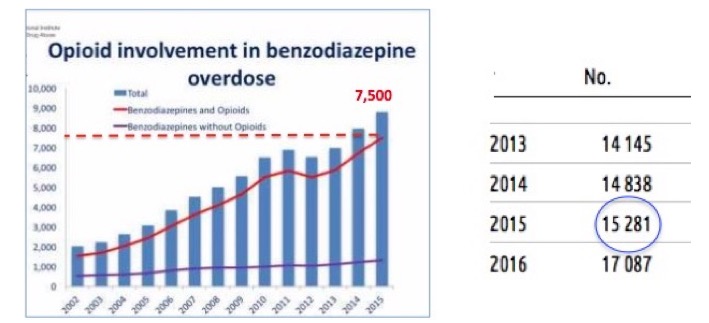Here's the title of an opinion piece in the April issue of the American Journal of Public Health, which was published by four authors at the CDC:
"Quantifying the Epidemic of Prescription Opioid Overdose Death"
I don't like the title very much. It (intentionally, no doubt) says approximately zero about what is contained within the article, which is mighty revealing. Since I'm nothing if not helpful, I thought I'd suggest a more candid title:
"We at the CDC Really Screwed Up and Here is Our Pathetic Attempt to Disguise it"
Then it gets downright hilarious. Check out this disclaimer. It's a real beauty:
"Note. The findings and conclusions of this editorial are those of the authors and do not necessarily represent the official position of the Centers for Disease Control and Prevention."
Really? So if I have this right, four people working for the CDC are allowed to write an opinion piece without any fear of jeopardizing their jobs. Who would have thought that federal agencies were so tolerant of employee dissent?? How about this one? Would the following opinion piece plus a disclaimer fly?
"The CDC Sucks"
"The findings and conclusions of this editorial are those of the authors and do not necessarily represent the official position of the Centers for Disease Control and Prevention, which may or may not suck."
I think not. So let's take a look at what's really in what is, in fact, a pathetic mea culpa, with a side order of stealth.
Halfway through the first sentence, it is clear that these guys are repeating the same old crap:
"In 2016, 63,632 persons died of a drug overdose in the United States; 66.4% (42,249) involved an opioid."
Why do I suspect that the CDC would be absolutely gleeful if reporters read only the first sentence and then wrote their same old crap? After all, it is much easier than actually reading the paper and seeing what's really in there. But if you bother to read it it doesn't take long until the funny business starts.
First, the authors state that there are (at least) two ways to count opioid deaths. And the CDC has been doing it wrong (emphasis mine):
Traditionally, the Centers for Disease Control and Prevention (CDC) and others have included synthetic opioid deaths in estimates of “prescription” opioid deaths. However, with [fentanyl] likely being involved more recently, estimating prescription opioid–involved deaths with the inclusion of synthetic opioid– involved deaths could significantly inflate estimates.

Shocking! Except that I have written numerous pieces (1) which conclude exactly this: By combining fentanyl deaths with those from prescription drugs it automatically skews the results. The stats from the CDC have been BS all along. They are now sheepishly admitting it, but not until the BS numbers were already used to formulate the god-awful policy which is now plaguing millions of us. All based on a bunch of lies.
It doesn't take long to find data in the article that makes the CDC and its flunkies (2) look pretty bad. Let's start with Table 1. The center column (green circle and arrow) represents the "traditional" method that the CDC used to count deaths. Note that the number doubled between 2013 and 2016. Those damn pills are stone cold killers, just like we've been told all along, right? No. Not right.

a "Natural opioids include morphine and codeine, and semisynthetic opioids include drugs such as oxycodone, hydrocodone, hydromorphone, and oxymorphone. Methadone is a synthetic opioid. Synthetic opioids, other than methadone, include drugs such as tramadol and fentanyl."
Table 1. (Left) A "new" method of categorizing opioid OD deaths includes only prescription drugs. (Center) The previous method included heroin and fentanyl, which automatically skewed the statistics. (Right) Deaths from illicit fentanyl. Modified from American Journal of Public Health (AJPH) April 2018

The other columns tell us why. The left column (blue) represents the number of deaths when the "conservative definition" (make that "correct definition") is used. The data in this column no longer includes deaths from "fentanyl" ("fentanyl" in this instance meaning illicit fentanyl and its analogs - synthesized in Chinese labs, not pharmaceutical fentanyl). Once "fentanyl" (red column) is removed from a category in which it should never have been in in the first place, all of a sudden, the number of deaths drops by half. That little "a" has a big meaning. This "a" explains why fentanyl is erroneously lumped in with the others.
WHERE IS HEROIN?
It is a bit baffling that heroin is not mentioned in footnote a. Especially since CDC data show that there were 15,469 opioid overdose deaths in 2016 (3). It is safe to assume that heroin was included in the data in the center column even though it was not specifically mentioned. It is not clear whether this omission is intentional or an oversight.
REDOING THE MATH
Now that we know that the 42,249 deaths that "involved an opioid" do not represent pain pills. If illicit fentanyl and heroin deaths are separated from the fake number we get a new number which is very different (4).
THE BIG LIE
The title of the middle column on Table 1 seems innocent enough: "Natural and Semi-Synthetic Opioids, Methadone and Other Synthetic Opioids." But it is not. There is a nasty trick buried in a seemingly innocent definition - a false and scientifically absurd distinction between synthetic, semisynthetic (synthesized from a naturally occurring opioid) and naturally occurring opioids. This system of classifying opioids places fentanyl in the first group, heroin in the second, and morphine in the third. Ridiculous. Opioids should be classified either as pharmaceutical (legal) or non-pharmaceutical (illicit) or by their potency.
This false classification would seem to be no more than a trick. By combining legally prescribed opioids with street drugs the CDC has generated phony data that supports its doctrine - that prescription medications are killing people en masse. They are not. Once the fallacy falls away things look quite different (Table 2).
Fentanyl deaths have shot up more than 6-fold in three years while deaths from oxycodone, codeine, morphine, etc. have risen by 18%. That is a very different scenario than what the CDC has maintained and the press has parroted. Yet we continue to battle pills while the real killer isn't pills, it's heroin and illicit fentanyl and fentanyl analogs, most of which are far worse than fentanyl itself. Drs. Michael Schatman and Stephen Ziegler also addressed the CDC lies in their 2017 piece in the Journal of Pain Research entitled "Pain management, prescription opioid mortality, and the CDC: is the devil in the data?" The piece is, uh, rather blunt.

Table 2. (Left) There was a 6.2-fold (520%) increase in fentanyl deaths between 2013 and 2016. (Right) By comparison, deaths from prescription opioid drugs increased by only 18%.
WITH OPIOIDS 2+2 MAY EQUAL 5
But it gets even worse. The deaths from pills very often include other drugs, which have a synergistic effect.

It is impossible to tell how many people who died from prescribed pills would have survived had they not taken other drugs along with the opioid. But it is possible to estimate how many of them who died had taken these other drugs. This number is large. For example, in 2015 (Figure 1) about half of the people who died from prescription opioid overdoses had also taken a benzodiazepine (e.g., Valium).

Figure 1. Benzodiazepines were present in 50% of prescription opioid deaths in 2015. Source: NIH
If benzodiazepines are present in so many opioid OD deaths then surely other drugs must also be frequently found, right? The answer is, of course, yes, but the numbers may astound you. Dr. Haylea Hannah and colleagues from the California Department of Health & Human Services recently published a paper in Online Journal of Public Health Information which examined toxicology data in people in Marin County who had died from any drug poisoning. Here are the findings:
- Opioids were present 76% of the time
- Alcohol - 44%
- Amphetamines - 24%
Perhaps more interesting:
- When an opioid was found in the tox screen, alcohol was also found 52% of the time
- The average number of drugs found all cases was 6 (!)
Once again, it is apparent that deaths from opioids occur from abuse, not use.
The more you dig the more the numbers change, and it's always in the same direction - the number of overdose deaths from prescription opioid medications, when used properly, is far less than the bogus numbers that have been used by the CDC. Based on all these adjustments, it would not surprise me in the least if 90% of opioid overdose deaths were a result of illicit fentanyl and its analogs, heroin, and the combination of pharmaceutical opioid drugs with other drugs of abuse. Maybe more.
It should be entirely clear that pain patients who use these painkillers correctly and responsibly are not the people who are dying from overdoses. But they are dying - slowly - from having to live in misery that we wouldn't allow for our pets as the medicines they need to (barely) function are being forcibly taken away.
It is 2018 and this is the United States. How did we ever get here?
NOTES:
(1) See:
The Opioid Epidemic In 6 Charts Designed To Deceive You
Heads In The Sand — The Real Cause Of Today's Opioid Deaths
How the feds are fueling America’s opioid disaster
(2) Yes, you guys. You know who I mean.
(3) Source: "Drug Overdose Deaths in the United States 1999–2016", CDC
(4) The "new" number is not 42,249 minus (fentanyl + heroin). It is much lower but unknown (and unknowable) because when more than one drug is found it is counted twice. A certain number of fentanyl deaths also involve heroin and the other way around. One cannot simply add or subtract columns because of multiple counting.




